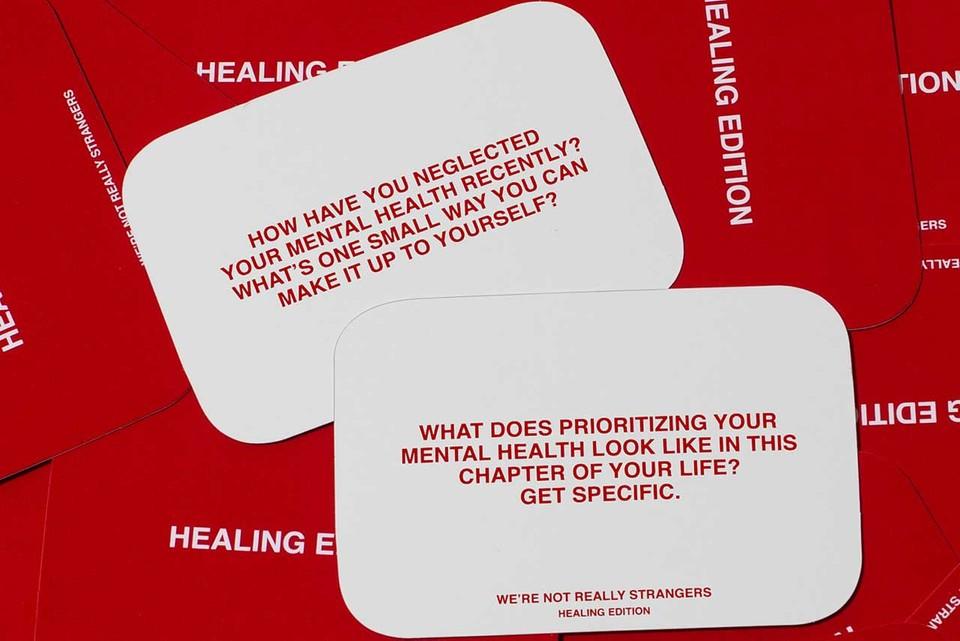Critical Play: Exploring Vulnerability and Connection in “We’re Not Really Strangers”
I decided to play “We’re Not Really Strangers,” a card game designed by Koreen Odiney, which facilitates deep, personal interactions among its players. I played the physical card version with two friends – one of them, I was already pretty close with and the other I didn’t really know too much before.
Central Argument
The essence of “We’re Not Really Strangers” lies in its ability to facilitate the process of getting to know others in a manner that feels natural and unforced. My argument is based on the idea that while players may be eager to connect, admitting that can sometimes feel awkward or overly direct. This game cleverly shifts the responsibility of initiating vulnerability from the individual to the game mechanics themselves. By doing so, it reduces the social risk associated with opening up, making players feel more comfortable and less exposed when sharing personal insights. This is the game’s most significant strength: it creates a safe space for vulnerability through structured interaction. It does this through its language (especially of the title “we’re not really strangers”), the three phases in increasing levels of vulnerability, and the questions themselves which often are just interesting to answer.
Game Mechanics
The game is ingeniously segmented into three levels of increasing intimacy, with each tier crafted to delve deeper into the backstory/personality of the participants. Unlike typical social games that spotlight individuals one at a time such as hot seat or paranoia, every round in “We’re Not Really Strangers” involves all players, fostering a shared vulnerability and collective participation. This inclusive approach helps to normalize personal fears and insecurities, establishing them as common experiences rather than isolated feelings. It also makes sure that everyone participates (and naturally helps alleviate the social risk of volunteering to go).
Analysis of Game Design
A standout feature of the game is the introduction of “wild cards,” which disrupt the standard question-answer format with prompts for actions such as calling a loved one or sharing a memory. These unpredictable elements add a dynamic layer to the gameplay, facilitating spontaneous emotional exchanges that can deepen the connection between players. To improve its appeal to a broader audience, the game could benefit from a more diverse array of questions and perhaps themed expansions that cater to different cultural or personal backgrounds. I would love to have a WNRS for musicians with music-themed questions and wild cards with musical tasks.
One critique I have is that the game assumes that all players are equally comfortable with deep introspection and may deter those who are more reserved or from cultures that prioritize privacy. Introducing adjustable settings for privacy or difficulty could mitigate this, allowing participants to engage at a pace that respects their comfort levels.
Evidence of Impact and Learning
Through its design, “We’re Not Really Strangers” aligns with the types of fun categorized by game designers as fellowship and discovery. The game consistently succeeds in helping players feel more connected to one another and more aware of their own emotional landscapes.
One moment I remember was a turning point with me and the friend I didn’t know as well. During one round, the question posed to us was, “Do you think I was popular in high school?” This question opened a heartfelt discussion between myself and the friend. As we delved into our responses, we discovered a shared experience: both of us were Asian-American and had navigated the challenges of growing up in predominantly white schools. This revelation led to a deeper conversation about our experiences with cultural identity and how we struggled to assimilate into American culture as we grew up.
Conclusion
“We’re Not Really Strangers” exemplifies how a seemingly card game can evolve into a powerful mechanism for fostering human connection. By encouraging players to share deeply personal thoughts and feelings, the game fulfills its premise that we are connected beyond surface-level interactions. Its thoughtful design encourages not just participation, but genuine engagement, resulting in deeply meaningful experiences that resonate with players long after the game ends.



